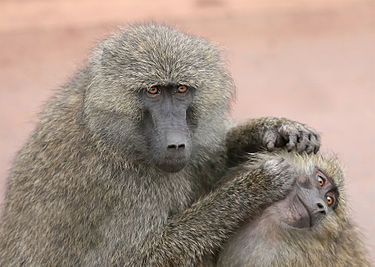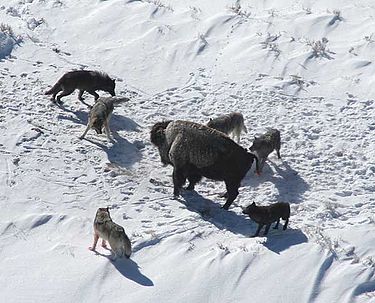Charles Darwin’ “Theory of Evolution”, explains that the traits which aids the survival and reproductive success of an individual will be selected and passed down to the offspring.[1] According to this definition, the evolution of altruistic behaviour seems highly impractical. This is because altruism is defined as the behaviour of an organism which, at the expense of the actor, increases the fitness of another individual. The evolution of altruism seems to distinctly defy the current ideas of natural selection and the “survival of the fittest.” The natural selection of self-harming traits required significant amounts of research and involved the evolution of numerous theories.

The Group Selection Theory
Amongst these theories was “The Group Selection Theory,” – a theory based on the idea that natural selection can also work on groups of organisms. The Group Selection Theory – first mentioned in Darwin’s book: “Origin of Species”- suggests that the most effectively functioning group would most likely survive and pass down their genes.[2] This theory works on the basis that the individual members always act altruistically for the betterment of the group of animals.
This would result in the overall fitness of the group of organisms being significantly higher than the mean fitness of an individual. For example, lions – the only true feline species – hunt in a pride. During a hunt, individual lionesses risk being injured severely or killed – an act of altruism- in order to increase the chances of a successful hunt.
However, this theory contains no explanation of how the selection pressures, which encourage groupism, would incentivise selfish, non-cooperating individuals to act altruistically. This is because the net benefit of acting altruistically often is significantly lower than that of selfish acts. Not participating in social activities such a hunt, would prevent the reduction in fitness of the individual.
There is no mechanism to ensure that the non-cooperating individual would not reap the benefits acquired for living in a group. This would hence increase the individual’s overall fitness and its chances of passing down genes. This would disincentive individuals from acting altruistically and therefore, through natural selection, allow selfish traits to prevail and thrive in a population.[3]
The Theory of Reciprocal Altruism
The “Theory of Reciprocal Altruism,” provides a sensible mechanism to incentive altruistic interactions between individuals. This theory, which was first established by Robert Trivers in 1971, suggests that an individual, who has been a receiver of an altruistic interaction, will reciprocate the favor in a future interaction to another individual, which largely is the original altruist. While this theory is on similar lines to the Kin Selection, unlike the latter, the former does not restrict interaction to members of the same clan. In fact, individuals do not even have to be a part of the same species.
The Theory of Reciprocal Altruism, is based on the idea that the benefit the receiver acquires during an altruistic act is significantly greater than the cost to the altruist. This would hence encourage individuals to act altruistically in hope of reciprocity, which would, on the long run, increase the fitness of an individual.[5]
Examples Reciprocal Altruism
An example of reciprocal altruism are the feeding habits of Vampire Bats. The diet of a Vampire Bat purely consists of blood, 70 hours without which the bat would not survive. Often individuals will not have consumed sufficient volumes of blood in a night and hence would be dependent on another bat to provide regurgitated blood, which the former would feed on. While obviously this interaction would have immense benefits to the latter, the former would be heavily impacted, hence proving this to be an altruistic act. Reciprocity interaction by these bats have been proven by data collected through various experiments conducted by George Wilkson. [4]

Flaws to the Theory
However one of the major flaws with the idea of reciprocal altruism, is that it is a highly unstable theory due to cheating. This is described as the instances when an individual does not reciprocate the altruism it has received. Therefore, in order for the theory to function, natural selection must favour the psychological mechanisms which controls an individual’s reaction to acts of both altruism and cheating by other individuals.
These mechanisms will prevent altruist interaction with cheaters, hence completely curbing any benefits the later receives from such acts of selflessness. If the benefit, which is forgone by the cheater is greater than the actual cost of reciprocating, this individual will eventually lose fitness. Hence, natural selection will not work in the favor of the cheater.[6]
Altruism requires the prevention of cheating
Natural selection is the main mechanism for preventing cheating in altruistic interactions. Nonetheless, there are numerous other factors which impact the chances of reciprocal interactions occurring.
Mutual Dependency
One of these factors is the degree of mutual dependence. The higher the mutual dependence, the higher the chances of altruistic acts being reciprocated. This is because mutual dependence often forces individuals to stay together in groups consisting of often unrelated organisms. These groups rely on each other for basic survival. This is either for increasing hunting success or, for prey, the avoiding of predation. This is very opportune for altruistic interactions being experienced together and also reciprocated.
Dispersal Rate
Another similar factor which impacts the chances of reciprocity is the dispersal rate of individuals. Lower dispersal rates mean that individuals are unlikely to migrate from their birthplace. Therefore the individual will have more repeated interactions with the same organisms in the region. This will provide for more opportunity to reciprocate any acts of altruism.
Dominance Hierarchy
The most significant factor which impacts the chances of reciprocal altruism acts occurring is the dominance hierarchy of social animals. Species with a distinct linear dominance hierarchy show less insistences of reciprocal altruism. As such, less dominant animals are more likely to act altruistically. Meanwhile, the chances of the leader of the group to reciprocate this is fairly low. For example, in lions, the dominant lion feeds first and consume the largest portions of the prey, despite not being involved in the hunt. This is in order to curb any “selection advantage food sharing may possess.” On the contrary, in social groups with a more relaxed dominance hierarchy, reciprocal altruism is more likely. [7]
The Conditions required for Reciprocal Altruism
As discusses above, there were flaws in the theory. To better explain reciprocal altruism, certain conditions have been mentioned. These conditions are as follows;
- Large number of interactions between the two individuals.
- Mechanism to detect and punish cheaters
- Fitness of receiver must be increased substantially in comparison to the benefit which a selfish act would provide[8]
The first condition is necessary to allow for reciprocal acts of altruism to occur. Meanwhile the second condition, as mentioned earlier is of utter importance. This in order to prevent individuals from unlimitedly benefiting from the altruist without any consequence. Lastly, the third condition is vital because if it was not such, receiving altruism is pointless.
Conclusion
There are numerous reciprocal strategies and mechanisms. Some strategies include direct, indirect and generalised reciprocity. Direct reciprocity is when the benefited individual only reciprocates the altruistic act to the original altruist individual. Secondly, indirect reciprocity is when an individual’s reputation amongst a group of organisms forms the basis of whether reciprocity acts of altruism is given. This is another mechanism to prevent cheating. Individuals with a poor reputation are often not helped. Meanwhile individuals with a good reputation are more likely to receive reciprocated altruism.[9]
Lastly, generalized reciprocity is when an individual decides to aid any other individual based on the fact that it has been benefited in the past, regardless of the identity of the identity of the original altruist. This promotes cooperation between unrelated individuals, hence resulting in the evolution of social behaviour in species.[10] These reciprocity strategies all have their benefits and disadvantages. However, it is essential that there are mechanisms to ensure reciprocal mechanism is maintained.
To conclude, the “Theory of Reciprocal Altruism” is the amongst the most ideal of explanations for the evolution of altruism. This is largely due to the effective mechanisms, in the form of natural selection, which hence result in the theory being viable.
If you like our content, do support our foundation by checking out our e-commerce platform.
[1] https://www.dictionary.com/browse/natural-selection
[2] https://blog.oup.com/2015/01/kin-group-selection-controversy/
[3] https://en.wikipedia.org/wiki/Altruism_(biology)
[4] https://en.wikipedia.org/wiki/Reciprocal_altruism#Theory
[5] https://psychology.wikia.org/wiki/Reciprocal_altruism
[6] https://greatergood.berkeley.edu/images/uploads/Trivers-EvolutionReciprocalAltruism.pdf
[7] https://plato.stanford.edu/entries/altruism-biological/#RecAlt
[8] https://doi.org/10.1093%2Fbjps%2F47.4.533
[9] https://royalsocietypublishing.org/doi/full/10.1098/rspb.2008.1715
[10] https://www.eurekalert.org/pub_releases/2007-07/plos-gri062607.php
